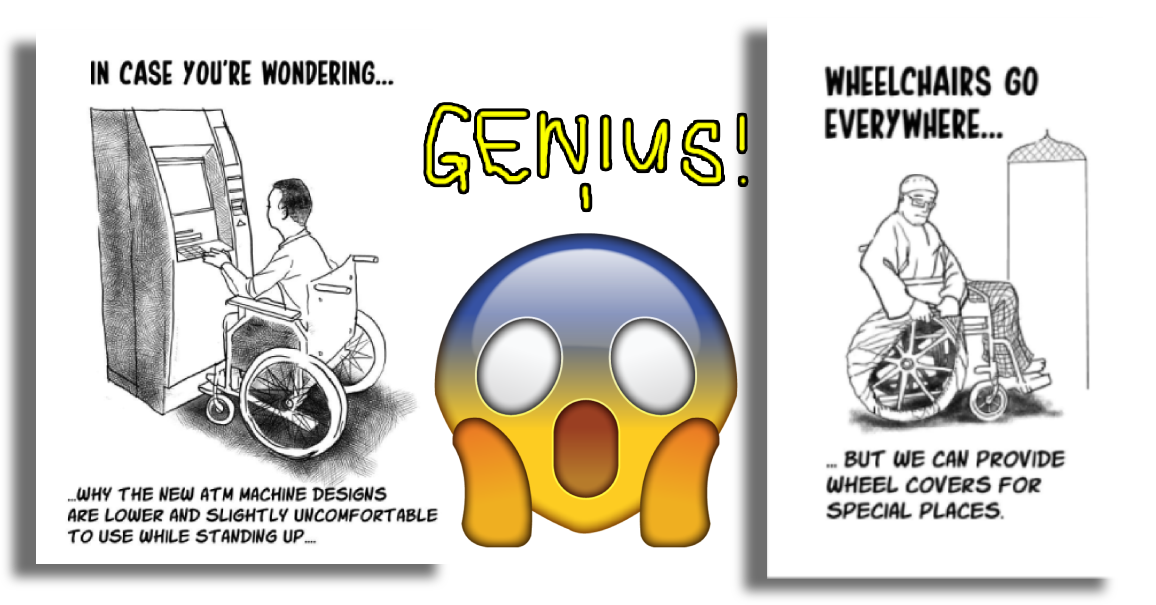We used a wheelchair in Klang Valley. Here’s how many times we got stuck.

- 359Shares
- Facebook352
- Twitter2
- LinkedIn1
- Email2
- WhatsApp2
A couple of weeks ago, I was waiting for the lift at the MRT station near my house, and I caught a glimpse of the OKU symbol above the doors. That got me thinking: how do people in wheelchairs get around, especially if they don’t or can’t drive?
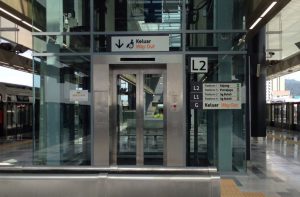
A few days later, these probing questions kept intruding into my usual thoughts, and I knew it was time for another CILISOS Experiment™. Rather than looking for people in wheelchairs to interview, I wanted to do give it a go myself cuz there are little little things you won’t really know until you experience it. That’s how it is for most things in life, innit?
So, I went and rented a wheelchair from Alpro Pharmacy, took our intern with me in case I got stuck somewhere, and tried wheeling around a couple of places, namely:
- Various LRT & MRT stations
- SS2, Petaling Jaya
- Petaling Street
- KL Sentral
- Dengkil R&R rest stop
…just to get an idea of how wheelchair-friendly the Klang Valley area is. Well, get this…
Wheelchair ramps often lead to dead ends or death traps
It’s mental how often I would see a wheelchair ramp and be like, “Cool, guess this area’s wheelchair-friendly”, and somewhere down the line, the path will lead to a set of stairs or an escalator with no other way out.
Take the Kelana Jaya LRT station, for instance. They’ve got a ramp leading out of the station, like so…
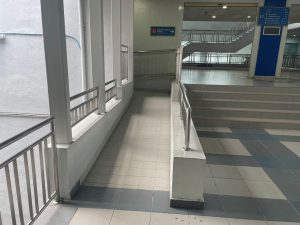
…and there’s a lift that leads you to the pedestrian bridge to get to the other side of the road…
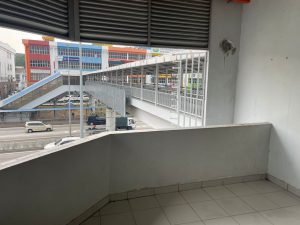
…aaaaaand escalator.

What are people in wheelchairs supposed to do here? But hey, at least I could wheel myself up the exit ramp at the station. The same could not be said for the ramp at the Plaza Rakyat LRT station. Look at how steep that is:
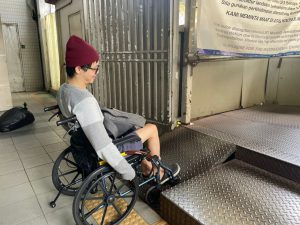
Our intern, despite her best efforts, couldn’t push me up either. Oh, and as a double whammy, the path after that ends in a set of stairs.

Sadly, it’s pretty much the same story at the business park where the CILISOS office is located at. Ramp…

…then stairs.
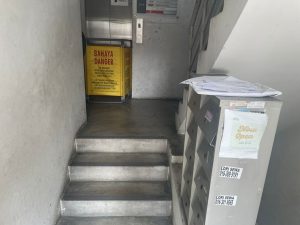
Even if you somehow managed to get up the stairs in your wheelchair, the lift has been out of service for almost 2 months. Halfway through the experiment, I caught myself asking if the ramps were there purely for the sake of fulfilling some sort of legal requirement.
I’ll probably never know for sure. There is one thing I can tell you for sure, though…
I was forced to be on the road way too often

Yeah, as much as I complained about terribly designed accessibility features, not having ramps that go onto sidewalks felt just as bad to me. This was something I realized almost as soon as I wheeled onto the street outside our office. I couldn’t get onto sidewalks because I was (literally) stonewalled by roadside curbs:
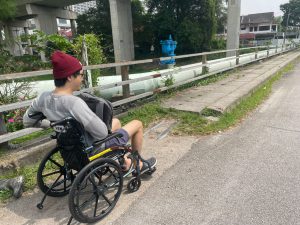
…so I spent a lot of time being dangerously close to traffic. This was an issue pretty much wherever I went. Housing tamans, shoplot areas, tourist spots, you name it. The stretch between Petaling Street and the Pasar Seni MRT station was particularly brutal, and that’s discounting the way people park their cars or bikes.

Even though that’s not really a problem to a regular person – you can just step around the parked vehicles – someone in a wheelchair would be absolutely screwed. Obviously, less of an infrastructure snag and more of a picture of how the ‘as long as it’s convenient for me’ mindset can negatively affect other people. Potholes and weirdly, longkang grills also proved to be hazards during the experiment:
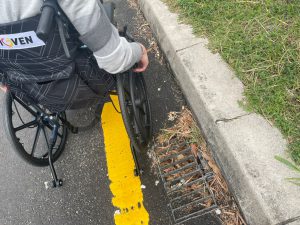
Honestly, this one’s maybe more on me for not properly paying attention to things on the road, but it’s still worth pointing out that getting your wheelchair stuck in a pothole or longkang grill would most likely necessitate help from kind passersby. Oh, and while we’re on the topic, I have to tip my cap at how…
Most Malaysians are willing to lend a hand to someone in need
You can most likely tell by now that I’ve gotten myself stuck quite a bit, and although our intern was there to get me unstuck whenever she could, she could only do so much. Hoisting a 70kg guy onto a curb ain’t easy. Thankfully, there were always nice people who would help me out. It was tricky for our intern to take pictures of the people who gave me a hand, so we ended up with only one:
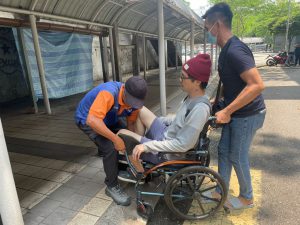
The guy in the blue and orange shirt even got off his van to help carry me onto the sidewalk. Really warms my heart as to how nice Malaysians generally are, even though some of them hesitated beforehand, probably wondering whether they were gonna appear patronizing by offering me help.
Anywho, piggybacking on the wholesome train, most of places that are more recently developed are quite wheelchair-friendly.
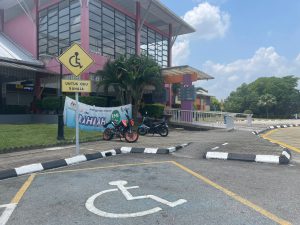
There’s a ramp that goes on to the sidewalk right beside the OKU parking. Nice.
We’re talking MRT stations, malls, even the one R&R station I visited. The ramps were gently sloped, and where there weren’t ramps, elevators were available. As someone who grew up in the late 90s and 2000s, the change was quite stark to me.
Having said that…
Malaysia’s accessibility is lagging behind some other countries

Braille directions on a handrail at CapitaGreen, Singapore. Img from The Guardian
Yes, we are making strides in the right direction with regard to taking into account the disabled in city planning, but we’re still rookies compared even to our immediate neighbor, Singapore. Over 95% of pedestrian walkways, taxi stands and bus stops in Singapore are, reportedly, accessible to wheelchair users, senior citizens and other people with disabilities. The CapitaGreen office building in the island nation’s central business district has won awards for being exceptionally accessible.
The office block is designed from the ground up to be that way – Braille instructions aplenty, lift doors that stay open longer, barrier-less exits from the two closest MRT stations, the whole shebang. It really helps the people who need it the most to live independently to an extent.
For those reading this and saying, “Only 11.1% of adult Malaysians are disabled what, why do we have to cater to them so much?”. To that I say, “Why not?”. At the end of the day, many people who have disabilities may want to and deserve to live like everyone else. They should be able to, for example, go to a KK Mart nearby unassisted. That’s why these accessibility designs are so important.
Also, the R&D that goes into accessibility design does inadvertently make life easier even for normally abled people. Take the barrierless MRT gates for example – that’ll ease congestion at the gates, especially in stations like Bukit Bintang and KLCC.
So yeah, why not?
- 359Shares
- Facebook352
- Twitter2
- LinkedIn1
- Email2
- WhatsApp2



